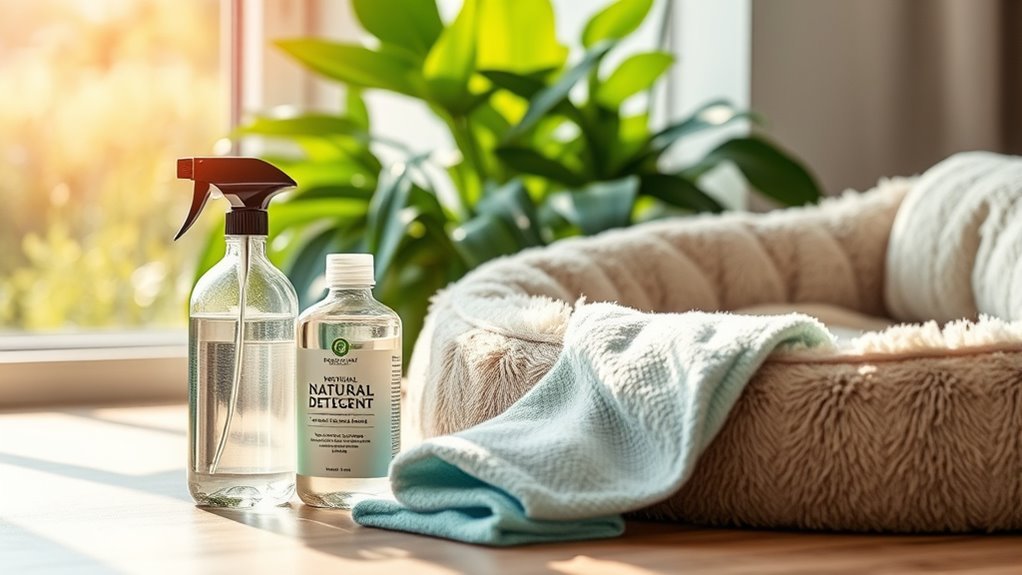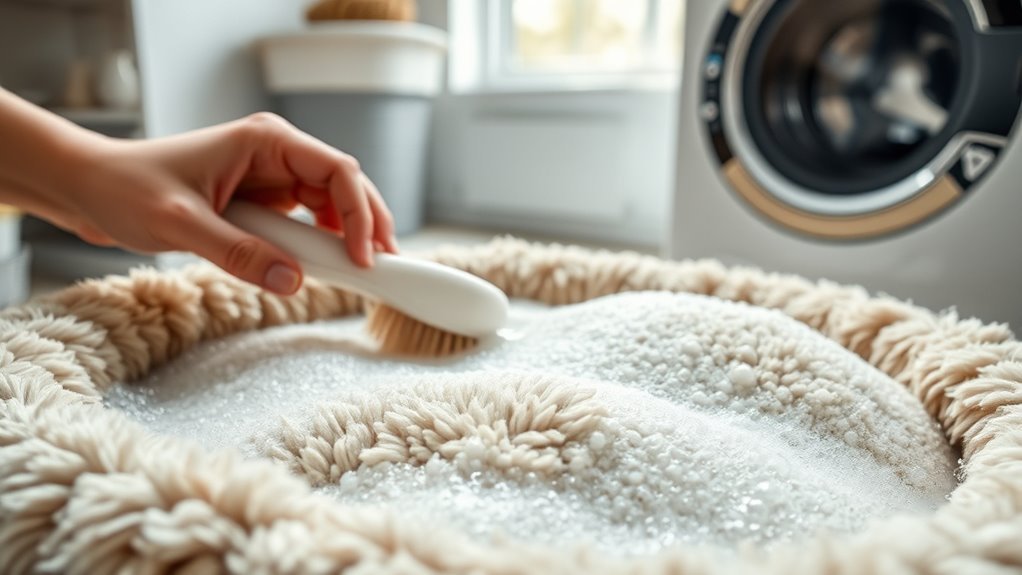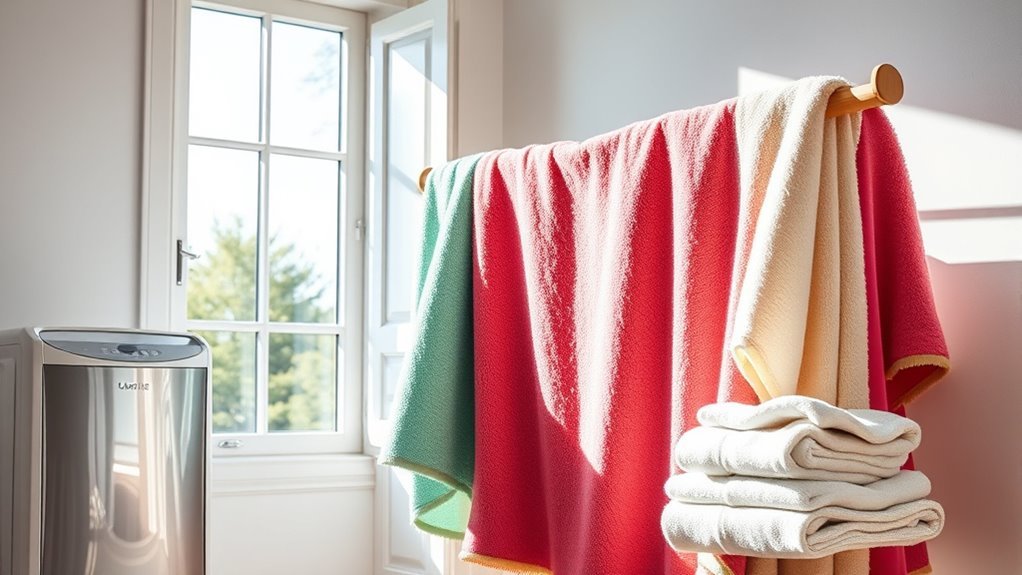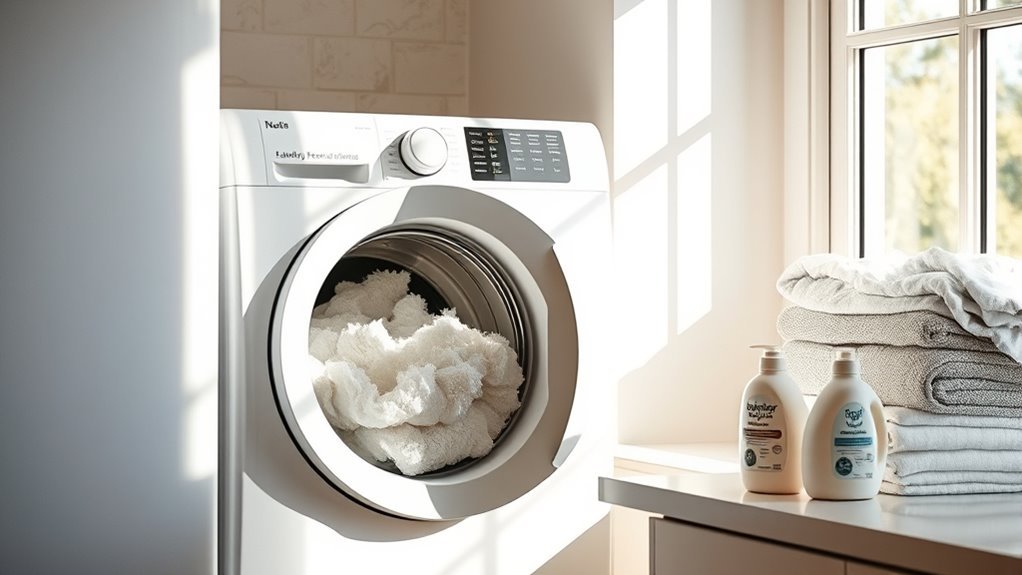How to Clean Pet Bedding Without Damaging It
To clean your pet’s bedding without damage, choose gentle, pet-safe detergents or natural alternatives like vinegar solutions. Remove loose dirt or fur first, then wash on a delicate cycle with cold water to protect fabric fibers. Air dry bedding to maintain softness and avoid shrinkage. Treat stains promptly using mild, pet-friendly products and sprinkle baking soda to neutralize odors. Follow these simple steps to keep your pet’s bedding fresh and comfortable, and discover even more tips to extend its life.
Choosing the Right Cleaning Products for Pet Bedding

When choosing cleaning products for pet bedding, you’ll want to prioritize those that are both effective and safe for your furry friend. You don’t have to settle for harsh chemicals that might irritate your pet’s skin or harm the environment. Instead, explore natural alternatives that clean thoroughly without toxic residues. Eco friendly options like plant-based detergents or vinegar solutions can tackle dirt and odors while keeping your pet’s bedding fresh and safe. These choices let you maintain your pet’s comfort and health without compromising your values or freedom to live sustainably. By selecting the right products, you guarantee your pet’s bedding stays clean and your home stays green, giving you peace of mind and a happier pet.
Preparing Pet Bedding for Washing
Before you toss pet bedding into the washing machine, you’ll want to take a few simple steps to prepare it properly. First, check the bedding’s fabric type—choosing fabrics that hold up well through washes means less hassle and longer-lasting comfort for your pet. Evaluating durability is key; look for tears, loose threads, or worn spots that might worsen during washing. Remove any loose dirt or fur by shaking or vacuuming the bedding outside to keep your machine clean. If the bedding has removable covers, unzip and separate them to wash individually. Also, secure any Velcro, zippers, or buttons to prevent damage. Taking these preparatory steps lets you clean your pet’s bedding efficiently while maintaining its quality, freeing you to focus on enjoying life with your furry friend.
Best Washing Techniques to Protect Fabric

To keep your pet bedding in great shape, you’ll want to choose gentle detergents that won’t damage the fabric. Washing with cold water helps preserve colors and fibers. Also, selecting a delicate cycle reduces wear and tear during cleaning.
Choose Gentle Detergents
Although you might be tempted to use strong detergents for a thorough clean, choosing gentle detergents is key to protecting your pet bedding’s fabric. Harsh chemicals can break down fibers, causing wear and discomfort for your furry friend. Instead, look for eco friendly options that clean effectively without harming the environment or your pet’s health. Hypoallergenic choices are also a smart pick, especially if your pet has sensitive skin or allergies. These detergents minimize irritation while still tackling dirt and odors. By opting for mild, safe cleaning agents, you maintain the bedding’s softness and durability, giving your pet a cozy space free from harmful residues. You’re not just cleaning; you’re preserving comfort and freedom for your best companion.
Use Cold Water
One of the simplest ways you can protect your pet bedding is by using cold water when washing it. Cold water benefits include preserving fabric integrity and preventing colors from fading. Choosing the right washing temperature not only extends your bedding’s life but also saves energy, giving you more freedom with your routine.
| Washing Temperature | Effect on Fabric |
|---|---|
| Cold (60-80°F) | Protects fibers, saves energy |
| Warm (90-110°F) | May cause slight shrinkage |
| Hot (130°F+) | Risks damage, fading |
Using cold water keeps the fabric strong and vibrant, so your pet’s bedding stays comfy and fresh longer. It’s a simple change that respects both your time and your pet’s comfort.
Opt for Delicate Cycles
Choosing cold water is a great start, but pairing it with a delicate cycle can make all the difference in preserving your pet bedding. Delicate fabrics need gentle handling, and machine settings designed for this purpose reduce wear and tear. When you select the delicate cycle, the washer uses slower spin speeds and shorter wash times, which prevents fabric distortion and fading. This means your pet’s bedding stays soft, intact, and comfy for longer. Don’t skip checking the care label; it often guides the best machine settings to protect delicate fabrics. By opting for a delicate cycle, you’re choosing freedom from frequent replacements and damage. It’s a simple step that saves time, money, and keeps your furry friend’s bedding in great shape.
Drying Methods That Preserve Bedding Quality

When you’re drying pet bedding, using the right method can make all the difference in maintaining its softness and durability. Air drying is your best bet if you want to keep the fabric’s integrity intact and avoid shrinkage or damage from high heat. Simply hang the bedding on drying racks in a well-ventilated space, letting natural airflow do its magic. This way, you preserve the cushioning and prevent any weird stiffness that dryers can cause. If you don’t have outdoor space, set up drying racks near a sunny window or use a fan to speed up the process. Avoid tossing pet bedding in the dryer frequently—it might be tempting, but it’ll wear out the material faster, limiting your pet’s comfort and your freedom from constant replacements.
Removing Stains and Odors Effectively
Tackling stains and odors on pet bedding requires a few targeted steps to keep your pet’s space fresh and inviting. Start by treating stains promptly—dab the area with a pet-safe stain removal solution or a mix of mild detergent and water. Avoid harsh chemicals that might irritate your pet or damage the fabric. For odor neutralization, sprinkle baking soda over the bedding and let it sit for 15-30 minutes before washing; it naturally absorbs smells without masking them. Afterward, wash the bedding in warm water with a gentle detergent designed to eliminate odors. This approach guarantees you remove stains effectively while keeping odors at bay, giving your pet a clean, comfortable spot to relax without compromising freedom or safety.
Tips for Regular Maintenance and Care
To keep your pet’s bedding fresh, stick to a routine cleaning schedule that fits your pet’s needs. Always choose fabric-friendly detergents to avoid irritating their skin. These simple steps will help maintain a clean and comfortable space for your furry friend.
Routine Cleaning Schedule
Although it might seem like a small task, establishing a routine cleaning schedule for your pet’s bedding can make a big difference in maintaining their health and comfort. Sticking to a consistent schedule keeps allergens and odors at bay, letting your furry friend enjoy a fresh, cozy spot every day. To set up an effective routine, focus on:
- Cleaning frequency: Aim to wash bedding at least once a week or more if your pet sheds heavily.
- Schedule consistency: Pick specific days for laundry to build a habit that’s easy to follow.
- Quick spot checks: Between washes, remove hair and dirt to extend freshness.
Fabric-Friendly Detergents
Choosing the right detergent is one of the simplest ways you can protect your pet’s bedding while keeping it clean and fresh. You want to pick fabric-friendly detergents that won’t wear down the fibers or irritate your pet’s skin. Look for eco friendly options that avoid harsh chemicals and toxins, helping both your pet and the planet. Fragrance free choices are ideal since strong scents can bother sensitive noses and cause allergic reactions. These detergents clean effectively without leaving residues that attract dirt or grime. By sticking to gentle, natural formulas, you maintain your pet’s bedding in great shape and extend its life. This small switch gives you freedom from worrying about damage and keeps your furry friend comfortable and safe every day.
Frequently Asked Questions
Can I Use a Washing Machine Sanitizer With Pet Bedding?
You can use a washing machine sanitizer with pet bedding, but you’ll want to check washing machine safety first to avoid damaging fabrics. Sanitizers can boost cleanliness, increasing sanitizer effectiveness against germs and odors. Just make sure the sanitizer you choose is pet-safe and compatible with your machine. This way, you’re free to keep your pet’s bedding fresh without risking wear or irritation—giving both you and your furry friend peace of mind.
How Often Should I Replace Pet Bedding Completely?
Think of pet bedding as a cozy nest that deserves fresh air often. Your replacement frequency depends on the bedding materials and your pet’s habits. For synthetic or memory foam bedding, swapping every 6-12 months works, while natural fibers might need quicker changes. If you spot wear, odors, or stains, it’s time. You want your furry friend’s freedom to lounge comfortably, so keep their space inviting and fresh with timely replacements!
Are There Specific Detergents Safe for Puppies or Kittens?
You’ll want to choose puppy safe detergents and kitten friendly cleaners to keep your little ones safe. Look for products labeled hypoallergenic, free of harsh chemicals, fragrances, and dyes. These gentle formulas won’t irritate their sensitive skin or respiratory systems. You can even find eco-friendly options that let you clean freely without worry. Always rinse bedding thoroughly to remove any detergent residue, so your pets stay comfortable and protected.
Can Pet Bedding Cause Allergies if Not Cleaned Properly?
Did you know that about 10-20% of people suffer from pet allergies? If you don’t clean pet bedding properly, allergy triggers like dander, dust mites, and bacteria can build up in bedding materials. This can cause sneezing, itching, or worse. You want to keep both you and your furry friend free from discomfort, so regular washing with gentle detergent is key. It’s all about enjoying pet freedom without the sniffles!
Is It Okay to Use Fabric Softener on Pet Bedding?
You might want to skip fabric softener on pet bedding since it can irritate your furry friend’s skin or reduce absorbency, especially depending on pet bedding materials like cotton or fleece. Instead, try fabric softener alternatives like white vinegar or baking soda during washing—they’re gentler and safer. These options help keep bedding fresh and comfy without harmful residues, letting your pet enjoy freedom from discomfort and allergies while you keep things clean and soft.






